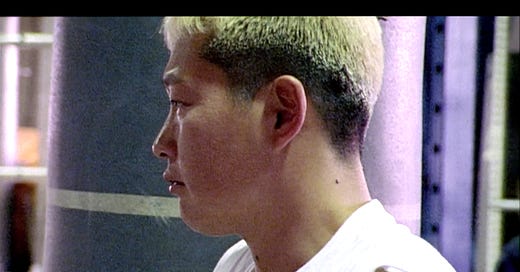Let’s start with the dropkick.
Chances are that if you’re a wrestling fan familiar with Gaea Girls (2000), you know about Meiko Satomura’s notorious dropkick. If you don’t, you understand its notoriety the moment it happens twenty-eight minutes into Jano Williams and Kim Longinotto’s documentary on Japanese women’s wrestling (otherwise known as joshi). A professional wrestling trainee, Saika Takeuchi, offers a series of simulated attacks that leave her trainer Satomura unsatisfied. Satomura grabs Takeuchi by the hair, howls “you’re taking the piss!”, flings the trainee across the ring, and jumps up to kick her square in the face. The resulting sound is quease-inducing; so is the fountain of blood that runs from Takeuchi’s mouth.
That dropkick is Gaea Girls’ biggest cultural imprint. A Youtube clip of the moment has been viewed hundreds of thousands of times; a gif of the incident will appear on Twitter every few months, outraging and amazing wrestling fans in equal measure. The dropkick remains the film’s biggest impact: Longinotto and Williams’ documentary work has been widely acclaimed, but Gaea cannot be found on streaming like Longinotto films Shooting the Mafia (2019) or Sisters in Law (2005). The film has never been released on Blu-ray, with boutique home-media label Second Run never granting the film a second run after its 2010 DVD release. So, for the time being, the quickest way to watch it is via a janky VHS rip of the film’s sole screening on BBC 2.
Unsurprisingly, this is not the greatest way to experience Gaea Girls, but it feels appropriate for the late 90s/early 00s wrestling boom — talk to avid watchers of the Japanese scene at the time and they’ll wax lyrical over trading burnt-in videotapes full of iconic matches. They may have traded tapes of Gaea Japan, the wrestling promotion that Longinotto and Williams focus on. Gaea was founded in 1994 by Chigusa Nagayo, a huge star in the 80s as part of tag team the Crush Gals. She was the megastar from joshi wrestling’s peak in national popularity — when we meet 1999 Nagayo in Gaea Girls, she’s in the later stages of her career, and unbeknownst to her, the country’s wrestling boom is nearing its end.
However, Gaea Girls is not concerned with the history of Nagayo’s career, the aftereffects of becoming an iconic figure, or Gaea Japan’s health. It’s invested in the trainees that attend the promotion’s countryside dojo, and what they go through to be worthy of Nagayo’s blessing. More often than not, nothing is worthy of her approval — even when Takeuchi graduates from being a trainee, it doesn’t come with Nagayo telling her why. In fact, Takeuchi receives an intense dressing down in front of her peers, only for Nagayo to return later on, barely acknowledging the trainee’s achievement.
Training to be a wrestler is something that requires passion to maintain — it hurts to learn, with a strong physical strain on the body. Nagayo’s dojo not only offers up physical strain but mental strain as well. Whenever she walks into the corrugated metal shed that functions as the dojo, it’s not going to be good news for anyone. She dresses down trainees, often lashing out with violence while established members of the Gaea roster stand about awkwardly. At one point, the former Crush Gal smiles and tells a returning trainee that she’ll kill them if they let her down. When a trainee decides to leave the dojo, stating that her enthusiasm for wrestling has totally left her body, Nagayo calls her an “ungrateful child” and vows to never forgive her. She calls another trainee an idiot and hits her hard in the head with a newspaper. It goes on. And on. And on. Satomura’s dropkick is pretty disgusting, but she at least tries to talk to her students and asks if they’re okay: she’s the Good Cop to Nagayo’s Bad Cop.
It’s obvious that Nagayo carefully considered her portrayal in the film, as she closes the film talking about the way she learned to treat others. Her father’s way of thinking was imparted onto her, but she takes pride in passing down this form of abuse rather than wanting to break it. You understand and pity her, despite the fact it makes you feel more than a little ill. As a psychological reveal, it’s a little pat to have unveiled as the skeleton key to the previous ninety minutes’ behaviour. You wish there were more questions asked, or at least different forms of observation: what was Nagayo’s own dojo experience like? What did the other trainers think?
Over and over again, the trainees have it drummed into them that they have to be tough and hit hard because otherwise they’ll get hurt in the ring — or hurt someone in the process. That’s a bitter pill to swallow, but is true of wrestling training. You have to make the fight feel real. And then, there’s taking liberties with that trust, as we see over and over again in Gaea Girls. However, you can feel the filmmakers shocked into stillness by its intensity, leaving little time for them to really interrogate why it’s allowed to happen. You wonder whether Nagayo’s fame grants her a free pass to act this way, but you wouldn’t know the degree of her fame by watching Gaea Girls, nor what she envisions for the promotion. The film is punishing, but repetitive in its punishment; stunning in its immersive approach, but stranded from any outside information to take it above voyeurism. Perhaps that’s why the dropkick became so notorious: it tells you all you need to know about the dojo in under ten seconds.
NEXT: The Days When I Don’t Exist (dir. Jean-Charles Fitoussi, 2003, France)







